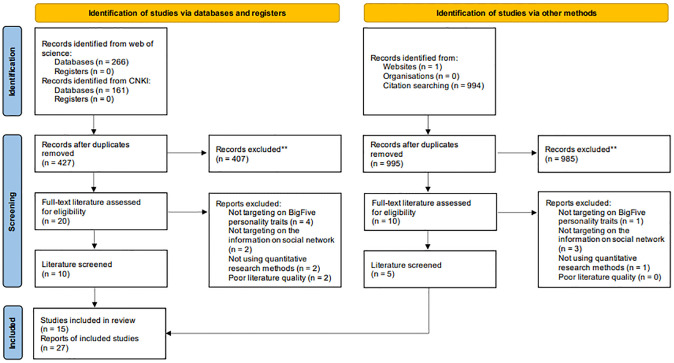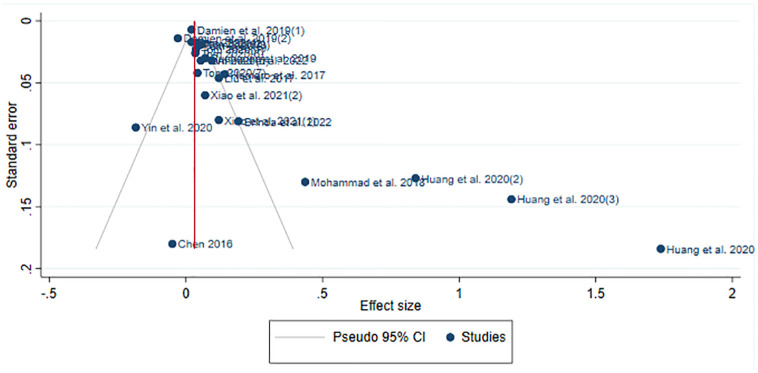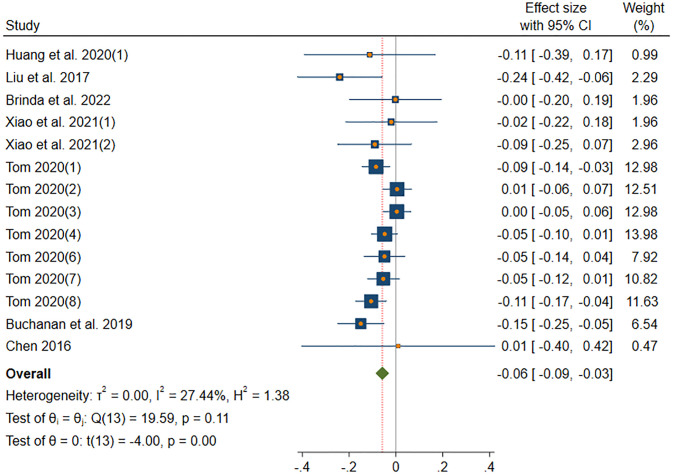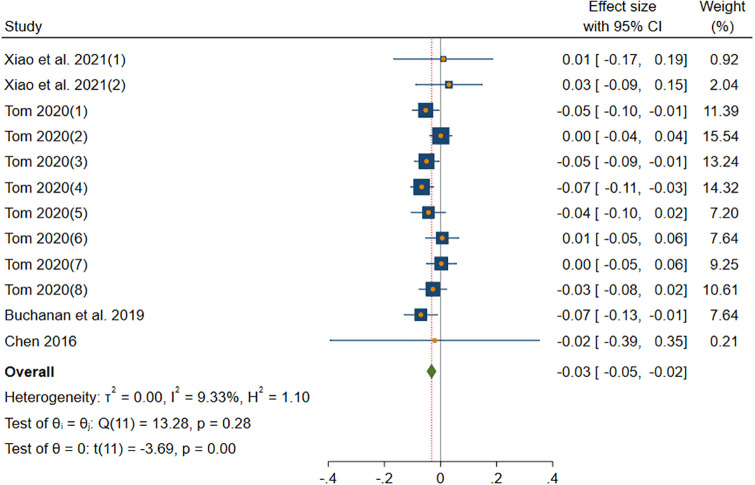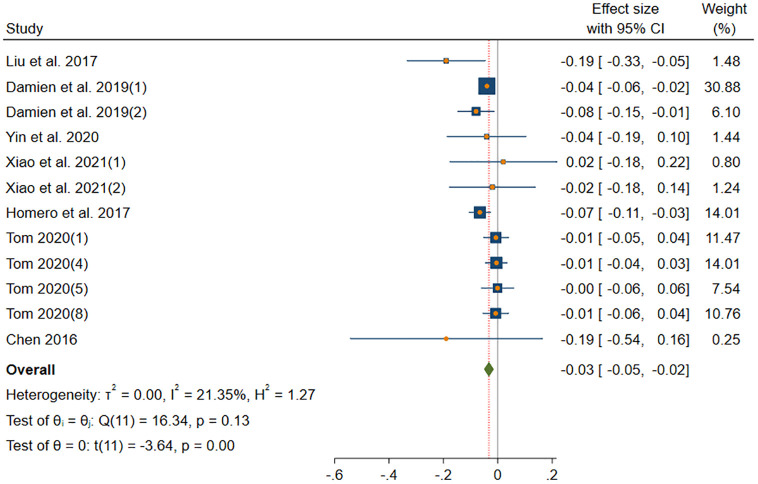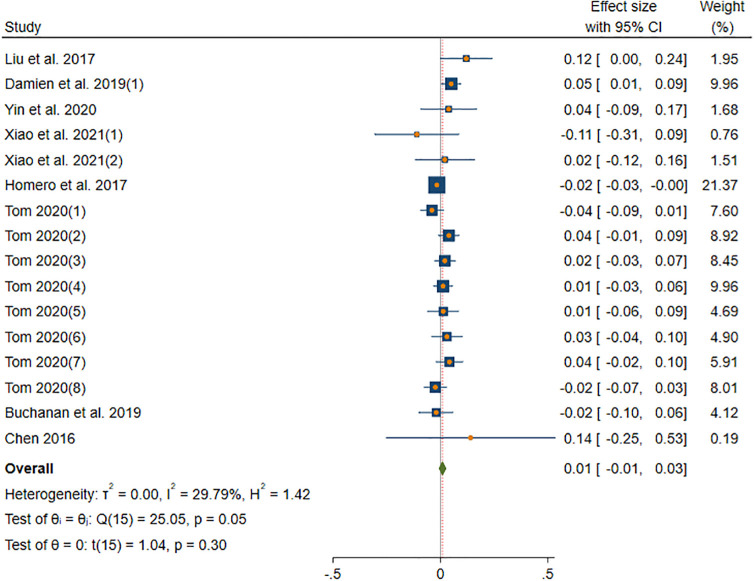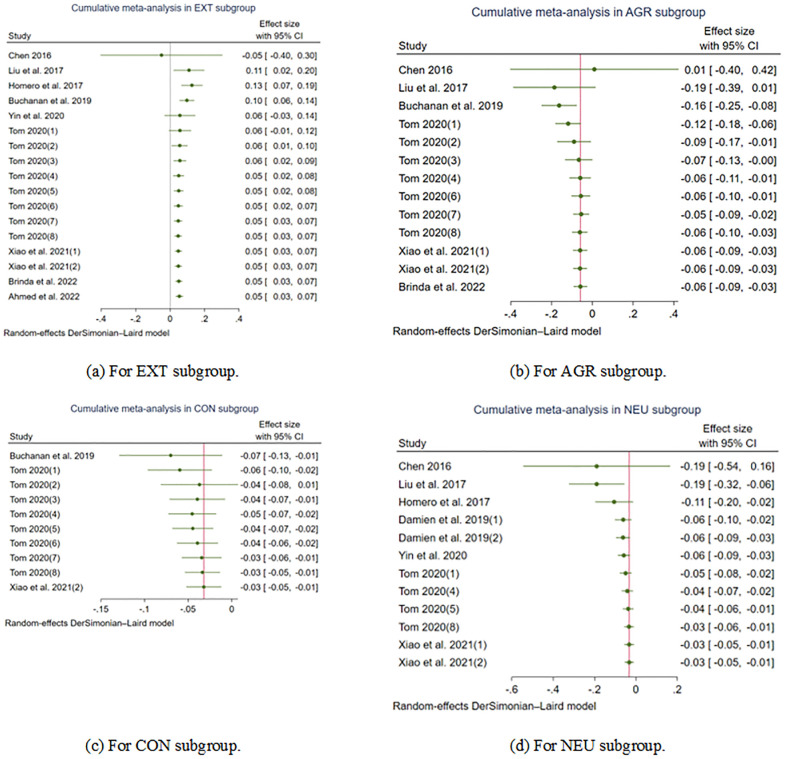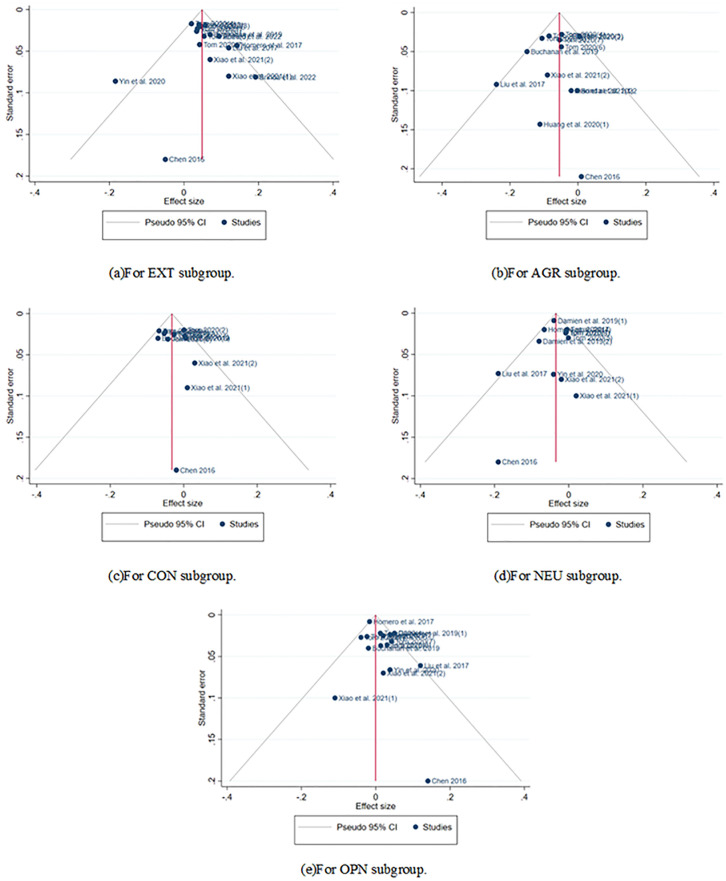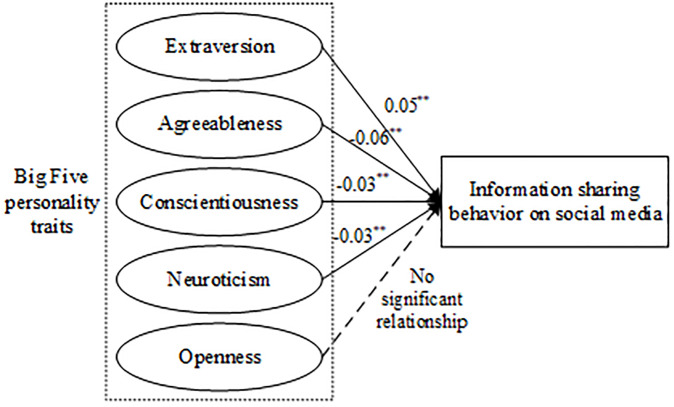Abstract
Research interest in information sharing behavior on social media has significantly increased over the past decade. However, empirical studies on the relationship between Big Five personality traits and information sharing behavior have yielded contradictory conclusions. We aimed to investigate how Big Five personality influences information sharing behavior on social media. This meta-analysis systematically reviewed high-quality studies indexed by web of science and CNKI from the past decade (n = 27, with 31969 samples) and performed a meta-analysis to examine the association between Big Five personality traits and information sharing behavior. The literature search was performed in September 2023. The meta-analysis results showed that extraversion (β = 0.05**) had a positive relationship with information sharing behavior on social media. Agreeableness (β = −0.06**), conscientiousness (β = −0.03**), and neuroticism (β = −0.03**) had negative relationships with information sharing behavior on social media. However, the relationship between openness and information sharing behavior was not clearly observed due to insufficient research. The meta-analysis results are made available to the scientific community to enhance research, comprehension, and utilization of social media.
1 Introduction
Social users continuously expand the scale of their presence as they engage in acquiring, sharing, and interacting with information, thereby maintaining, strengthening, or reconstructing their existing social relationships [1, 2]. Research on the constant dissemination of diverse information on social media can contribute to detecting rumors [3, 4], improving recommendation systems [5], marketing [6], managing social media [7, 8] and employee [9], and addressing other related areas.
The sharing behavior of social media users largely determines the dissemination of information on social media [10]. Personality traits, which are stable patterns of thoughts, feelings, and behaviors, have a significant influence on human cognitive patterns [11–13]. This makes it an excellent starting point for studying information sharing behavior on social media. The Big Five personality model is the most commonly used personality taxonomy in information science [14]. The Big Five personality traits are often integrated into research methods in areas such as rumors, recommendation systems, employee management, etc. However, although many review studies have investigated the correlation between the Big Five personality traits and human behavior [11, 15–17], the association between personality and information sharing behavior has not been thoroughly examined. In addition, there is no published meta-analysis on the relationship between two. The conclusions drawn between the two remain complex and unclear. This may lead to introducing personality traits in the method, which could be counterproductive. So, in this meta-analysis, we identified the connection between Big Five personality traits and information sharing behavior through a meta-analysis, which is a quantitative literature review method, to more effectively examine the human element in information science. The results may point to one of the bottlenecks faced by personalized research in information science.
This paper begins by providing definitions of Big Five personality traits and Information sharing behavior. Then, the research questions and hypotheses of this study are proposed. The adopted materials and methods of the meta-analysis are subsequently described. Section 5 presents the results of the meta-analysis, which is subsequently followed by a discussion of these results in section 6.
2 Theoretical review
2.1 Big five personality
Personality has been defined as “psychological qualities that contribute to an individual’s enduring and distinctive patterns of thinking, feeling, and behaving.” Various theorists have developed several models of personality, each representing different perspectives, such as Five Factor Model, Myers–Briggs Type Indicator, Eysenck’s three factor model, and seven-factor personality model.
The Five Factor Model, also known as the “Big Five” model of personality, is the most widely accepted and well-known theory within the dispositional perspective of personality. Big Five personality comprises five broad traits: extraversion (EXT), agreeableness (AGR), conscientiousness (CON), neuroticism (NEU) (or called emotional stability), and openness (OPN). The chaotic nature and lack of easy conclusions can be observed in agreeableness, conscientiousness, and openness and social media behavior. For instance, according to Indu et al. [18], individuals characterized by high extroversion and low agreeableness tend not to disseminate rumors. However, Buchanan [19] proposes that those who propagate false information feature lower agreeableness, yet exhibit higher levels of extroversion and neuroticism. As another example, various literature report the relationship between openness and information sharing behavior. However, contrary to these reports, a study by Zuniga et al. [20] found no significant correlation between these variables in a large sample. Meta-analysis is suitable for summarizing these confusing conclusions.
2.2 Information sharing behavior on social media
Due to its real-time, interactive, and diverse content characteristics, social media has gradually become an essential aspect of people’s daily lives over time. On these platforms, various types of information are shared, including entertainment information, health information, emergency information, political information, even rumor [18] and fake news [21]. The continuous sharing of such information enhances the appeal and usefulness of social media. In social media, information publishing, commenting, and forwarding all belong to information sharing behaviors, which transmit useful information to others.
Multiple psychometric measurement instruments have been created to evaluate individuals’ willingness to share information, including the Knowledge-sharing Behaviours Scale [22] and Information Exchange Scale [23]. However, no recognized specific scale has been developed to assess willingness to share information specifically on social media platforms. In addition to designing questionnaires, currently, researchers evaluate this willingness primarily through statistical design media data and interviews.
3 Research questions and hypothesis
The purpose of this meta-analysis was to consolidate all existing empirical evidence on the connection between Big Five personality traits and information sharing behavior on social media. So, RQ1:Do the information sharing behavior of users on social media correlate with their (a) extraversion, (b) agreeableness, (c) conscientiousness, (d) neuroticism, and (e) openness?
The extraversion trait distinguishes social, proactive individuals who are oriented towards themselves from silent, serious, shy, and quiet individuals. It is often considered highly positively correlated with the frequent use of social media [17, 24, 25]. Neuroticism reflects the individual emotional regulation process. Those with high neuroticism exhibit heightened reactivity to external stimuli compared to the general population, and they generally struggle with regulating and responding to emotions, often experiencing negative emotional states. It is often considered negatively correlated with the sharing behavior, since individual with high neuroticism tend to feel shy, anxious, insecure, and awkward in social situations [26, 27]. Agreeableness measures an individual’s attitude towards others. Conscientiousness distinguishes between individuals who are trustworthy and meticulous from those who are lazy and careless. Openness refers to an individual’s cognitive style, their capacity to tolerate unfamiliar situations, and their aptitude for exploration. So, based on our explanation of the Big Five personality traits and the previous literature of personality traits and human cognitive abilities [11], the following hypotheses were proposed for the meta-analysis:
H1: Extraversion is positively related to information sharing behavior on social media.
H2: Agreeableness is negatively related to information sharing behavior on social media.
H3: Conscientiousness is positively related to information sharing behavior on social media.
H4: Neuroticism is negatively related to information sharing behavior on social media.
H5: Openness is positively related to information sharing behavior on social media.
4 Material and methods
4.1 Literature searching and screening
A thorough literature search was conducted by two independent researchers in September 2023, among major databases involving Web of Science® and China National Knowledge Infrastructure® (CNKI). To ensure the quality of the literature, we only selected literatures indexed by Science Citation Index or Engineering Index (for literature written in English) and Core Journals of Peking University (http://hxqk.lib.pku.edu.cn/) (for literature written in Chinese). This rule filters out most low-quality articles in CNKI [28]. Due to the timeliness of social media research, we only adopt literature from the past decade (2012–2023). Given the main research objectives, we searched literature with multiple keywords, which include “personality”, “social media”, “information”, “sharing”, “dissemination”, “public opinion”, “人格” “传播”, “社交媒体” “舆情” and “信息共享” by Boolean search terms. We also gathered references from literature identified for inclusion in the meta-analysis, thereby adding five more papers to the final meta-analysis.
In addition to screening for journal papers and conference papers, relevant dissertations (e. g., [29]) were also screened to avoid potential bias. We subsequently screened the eligible papers using one criterion. That is, the paper must adopt Big Five as the personality taxonomy (e. g., [30]), and it’s research object must be the share behavior of social media. After eliminating duplicated articles resulting from the utilization of multiple databases and channels, the titles and abstracts of all retrieved papers were initially screened, which resulted in a total of 1421 papers at the preliminary stage, and a total of 15 papers and 27 studies in final. The selecetion process was also conducted by two independent researchers. The searching and selecetion process is shown in Fig 1.
Fig 1. PRISMA flow diagram of the meta-analysis.
A paper may present findings from numerous studies.
4.2 Effect size
Consistent with previous meta-analysis in personality [31–33], our study has applied the standardized regression coefficient β and standard error SE as the primary metric to estimate effect size. Almost all paper report β between personality traits and information sharing behavior. The larger |β|, the greater the impact of the independent variable on the dependent variable. For papers reporting other indicators for measuring the degree of statistical distribution (i.e., t in t-distribution, P value, standard deviation SD, mean difference MD), we use the following formula to approximately convert these indicators to SE.
| (1) |
| (2) |
Where, n is total number of samples. t can be obtained by consulting the t-value distribution table with the P value and the degree of freedom (n − 1). When the paper does not provide the precise P value but instead presents the level of significance, we proceed with the following approximating.
| (3) |
4.3 Coding and data analysis
According to a predefined coding schema, every paper was coded for the following information: (1) the relevant bibliographic information including the author(s), year of publication, and the country where sample were collected was recorded; (2) the sample characteristics including the number of sample, mean age of the sample, and the percentage of males; (3) the Big Five personality scale used in the study (e.g., BFI, NEO-PI-R, MINI-IPIP, etc.); (4) the information Sharing Scale used in the study (e.g., Likert-type Scale); (5) the effect size of Big Five personality traits assessed in the study.
The random-effects model called DerSimonian-Laird [34] was used to determine whether the average correlations were statistically significant, considering the variation among the included studies. We adopted the Q statistic, H statistic, and I2 statistic to test the heterogeneity across effect sizes in our chosen papers. The Q statistic measures the difference between observed effect sizes and the estimated effect size. The H statistic is the correction of the freedom degree for Q. The I2 statistic represents the percentage of variability in effect sizes that is unrelated to sampling error. Forest plots visually depict the heterogeneity included in our meta-analysis. In addition, due to the research differences between the Big Five personality traits, we divided the literature into five subgroups for analysis based on the Big Five personality traits. This helps to reduce heterogeneity among the included studies.
4.4 Publication bias
Recognizing the publication bias toward positive findings in the personality research community [17], we conducted two methods to determine if any publication bias exists. Firstly, a funnel plot was utilized to visually assess if there were any missing studies with small effect sizes. Next, Begg’s test with non parametric rank correlation and Egger’s test was employed to provide statistical evidence of publication bias [35].
Overall, Tables 1 and 2 presented the information of all studies included in this meta-analysis. All calculations related to this meta-analysis were conducted in Stata 17.
Table 1. Studies included in the meta-analysis.
| No. | Study | Country | Year | Object | sample | Mean age | % of males | Personality Scale | Information Sharing Scale |
| 1 | David et al. 2012 (1) [40] | World | 2012 | Social networking service | 300 | 27 | 31 | BFI-44 | Likert-type (1∼7) |
| 2 | David et al. 2012 (2) [40] | World | 2012 | Social networking servic | 300 | 27 | 31 | BFI-44 | Likert-type (1∼7) |
| 3 | Chen 2016 [27] | World | 2016 | Fake message | 171 | 24 | 42.69 | BFI-44 | Likert-type (1∼7) |
| 4 | Liu et al. 2017 [41] | China | 2017 | Social business information | 267 | 22.04 | 44.94 | TIPI-C | Likert-type (1∼7) |
| 5 | Homero et al. 2017 [20] | 20 country | 2017 | Message | 21314 | x | x | NEO-PI-R | Likert-type (1∼10) |
| 6 | Deng et al. 2017 [42] | China | 2017 | Message | 311 | 21.96 | 42.1 | NEO-PI | Likert-type (1∼5) |
| 7 | Mohammad et al. 2018 [25] | World | 2018 | Government information | 257 | 38.91 | 62.01 | NEO-PI-R | Likert-type (1∼7) |
| 8 | Damien et al. 2019 (1) [43] | World | 2019 | Message with emotional information | 197 | 44.9 | 48.94 | BFI-10 | Binary questioning |
| 9 | Damien et al. 2019 (2) [43] | World | 2019 | Message with facial expressions | 197 | 44.9 | 48.94 | BFI-10 | Binary questioning |
| 10 | Buchanan et al. 2019 [44] | USA, UK | 2019 | Fake message | 409 | x | 31.5 | IPIP | Statistics on Facebook |
| 11 | Huang et al. 2020 (1) [45] | China | 2020 | Entertainment information | 317 | 30.26 | 50.16 | Modified BFI | Likert-type (1∼5) |
| 12 | Huang et al. 2020 (2) [45] | China | 2020 | Social Communication Information | 317 | 30.26 | 50.16 | Modified BFI | Likert-type (1∼5) |
| 13 | Huang et al. 2020 (3) [45] | China | 2020 | Self-expression information | 317 | 30.26 | 50.16 | Modified BFI | Likert-type (1∼5) |
| 14 | Yin et al. 2020 [46] | China | 2020 | Negative news | 215 | 22.45 | 41.4 | BFI-44 | Intention of RNI |
| 15 | Tom 2020 (1) [19] | UK | 2020 | Later known fake message | 672 | 44.92 | 47.2 | 41-item BFI | Likert-type (0∼11) |
| 16 | Tom 2020 (2) [19] | UK | 2020 | Later known fake message | 674 | 38.95 | 46.3 | 41-item BFI | Likert-type (0∼11) |
| 17 | Tom 2020 (3) [19] | UK | 2020 | Later known fake message | 650 | 33.07 | 34.6 | 41-item BFI | Likert-type (0∼11) |
| 18 | Tom 2020 (4) [19] | USA | 2020 | Later known fake message | 638 | 44.91 | 44.4 | 41-item BFI | Likert-type (0∼11) |
| 19 | Tom 2020 (5) [19] | UK | 2020 | Known fake message | 672 | 44.92 | 47.2 | 41-item BFI | Likert-type (0∼11) |
| 20 | Tom 2020 (6) [19] | UK | 2020 | Known fake message | 674 | 38.95 | 46.3 | 41-item BFI | Likert-type (0∼11) |
| 21 | Tom 2020 (7) [19] | UK | 2020 | Known fake message | 650 | 33.07 | 34.6 | 41-item BFI | Likert-type (0∼11) |
| 22 | Tom 2020 (8) [19] | USA | 2020 | Known fake message | 638 | 44.91 | 44.4 | 41-item BFI | Likert-type (0∼11) |
| 23 | Xiao et al. 2021 (1) [21] | World | 2021 | Fake news published by social media | 551 | 20.26 | 29.65 | MINI-IPIP | Likert-type (0∼6) |
| 24 | Xiao et al. 2021 (2) [21] | World | 2021 | Fake news published by news media | 551 | 20.26 | 29.65 | MINI-IPIP | Likert-type (0∼6) |
| 25 | Brinda et al. 2022 [47] | India | 2022 | News | 221 | 28.59 | 42 | NEO-PI | Likert-type (1∼5) |
| 26 | Ahmed1 et al. 2022 [48] | Singapore | 2022 | News of COVID-19 | 500 | >21 | x | BFI-44 | Likert-type (1∼5) |
| 27 | Xu et al. 2023 [49] | China | 2023 | Online public opinion on newly emerging infectious diseases | 300 | 20–35 | 44 | Random forest | Statistics on WeiBo |
× represents that the effect size cannot be calculated due to insufficient data. ∼ represents that the effect size cannot be calculated due to the personality trait has not been studied.
Table 2. Result of quality assessment.
| Study | Title | Score |
|---|---|---|
| David et al. 2012 | A tale of two sites: Twitter vs. Facebook and the personality predictors of social media usage | 9 |
| Chen 2016 | The Influences of Personality and Motivation on the Sharing of Misinformation on Social Media | 9 |
| Homero et al. 2017 | Personality Traits and Social Media Use in 20 Countries: How Personality Relates to Frequency of Social Media Use Social Media News Use, and Social Media Use for Social Interaction | 10 |
| Deng et al. 2017 | How do personality traits shape information-sharing behaviour in social media? Exploring the mediating effect of generalized trust | 9 |
| Liu et al. 2017 | 社会化商务下个体心理因素对信息共享行为的影响——大五人格的调节作用 | 9 |
| Mohammad et al. 2018 | Sharing Political Content in Online Social Media: A Planned and Unplanned Behaviour Approach | 10 |
| Buchanan et al. 2019 | Spreading Disinformation on Facebook: Do Trust in Message Source, Risk Propensity, or Personality Affect the Organic Reach of “Fake News”? | 10 |
| Damien et al. 2019 | Willingness to Share Emotion Information on Social Media: Influence of Personality and Social Context | 8 |
| Huang et al. 2020 | 自媒体用户信息共享行为动机分析与实证 | 9 |
| Tom 2020 | Why do people spread false information online? The effects of message and viewer characteristics on self-reported likelihood of sharing social media disinformation | 10 |
| Yin et al. 2020 | Reposting negative information on microblogs: Do personality traits matter? | 9 |
| Xiao et al. 2021 | Wired to seek, comment and share? Examining the relationship between personality, news consumption and misinformation engagement | 9 |
| Brinda et al. 2022 | Fake or real news? Understanding the gratifications and personality traits of individuals sharing fake news on social media platforms | 10 |
| Ahmed1 et al. 2022 | Social Media News use and covid-19 misinformation engagement: Survey study | 9 |
| Xu et al. 2023 | EID事件情境下情绪对信息分享行为的动态影响——人格特质的调节作用 | 8 |
| Kim et al. 2014 | Individual Differences in Social Media Use for Information Seeking | 6 |
| Luo 2018 | 社交媒体中用户人格特质对科学信息分享动机的影响与反思 | 7 |
Fig 2 visually displays the significant publication bias present in our chosen papers. We employed the Leave-one-out method for sensitivity analysis to remove the most extreme outlier studies [36, 37].
Fig 2. Funnel plot of our chosen papers (for EXT trait).
The highly asymmetric nature indicates a strong presence of publication bias. Funnel plots for other personality traits are similar to this.
4.5 Quality assessment
Although most quality checklists published in extant academic literature have primarily addressed medical studies, we sought to ensure the thorough evaluation of the selected studies by adhering to a combination of established guidelines. To rigorously assess the methodological quality of the studies included in this meta-analysis, we followed the guidelines of Kitchenham and Charters [38] as well as the meta-analysis on the existing quality assessment tools that are being used in meta-analysis in the area of Engineering [39]. The study suggested using a set of questions based on widely used checklists and guidelines for the design, conduct, analysis, and conclusions of each study in this meta-analysis. The study evaluation criteria were based on the questions presented below.
Q1: Are the aims of the research clearly defined?
Q2: Is there an adequate description of the context in which the research was carried out?
Q3: Was the research design appropriate to address the aims of the research?
Q4: Was there a control group?
Q5: Are the data collection methods adequately described?
Q6: Were all measures used in the study fully defined?
Q7: Is the experimental design appropriate and justifiable?
Q8: Does the study provide description and justification of the data analysis approaches?
Q9: Are the findings of the study clearly stated?
Q10: Does the study add value to academia or practice?
The scoring procedure assigned a value of 1 for “Yes” and 0 for “No”. Studies could score between 0 and 10 points. Papers receiving a score exceeding 8 (>8) were decided to be retained in this meta-analysis. The results of quality assessment are presented in Table 2.
5 Results
5.1 Description of the study
As shown in Tables 1 and 2, the studies were conducted over the world (29.6%), seven studies (25.9%) were conducted in China, and six studies (22.2%) were conducted in UK. In 14 studies (51.8%) social media users were recruited (mean age from 30 to 45 years), in 9 studies (33.3%), the sample comprised social media users (mean age from 20 to 30 years). And the mean age of the sample in 4 studies (14.8%) could not be accurately determined. Most of studies (96.3%) have recruited less than 1000 participants. The following Big Five Personality Scale were adopted: BFI-44 [50] in 4 papers (26.7%), NEO-PI [51] in 2 papers (13.3%), NEO-PI-R [52] in 2 papers (13.3%), 41-item BFI [53] in 2 papers (13.3%) and 9 studies, BFI-10 [54] in 1 paper (6.67%), Mini-IPIP [55] in 1 paper (6.67%), TIPI [56] in 1 paper (6.67%), and machine learning-based method in 1 paper (6.67%). The Big Five personality traits were studied in the 22 studies (81.5%). Likert-type scale were designed to assess users’ willingness of information sharing in 22 studies (81.5%). And statistical data on social media were adopted to assess the willingness in 2 studies (13.3%). There were no outliers (i.e., no studies with a SE exceeding 0.21).
5.2 Results of meta-analysis
EXT-information sharing
Fig 3 shows the results of DerSimonian-Laird model in EXT subgroup. The DerSimonian-Laird model yield a significant moderate effect size (β = 0.05, p(β) < 0.001). The 95% confidence interval (CI) ranged from 0.03 to 0.07. The effect of this subgroup is homogenous (I2 = 31.6% < 50%, H = 1.2 < 1.5, Q(16) = 25.28, p(Q) = 0.07 > 0.05).
Fig 3. Forest plot displays the average correlation between the EXT trait and information sharing behavior across multiple studies.
AGR-information sharing
Fig 4 shows the results of DerSimonian-Laird model in AGR subgroup. The DerSimonian-Laird model yield a significant moderate effect size (β = -0.06, p(β) < 0.001). The 95% CI ranged from -0.09 to -0.03. The effect of this subgroup is homogenous (I2 = 27.44% < 50%, H = 1.17 < 1.5, Q(13) = 19.59, p(Q) = 0.11 > 0.05).
Fig 4. Forest plot displays the average correlation between the AGR trait and information sharing behavior across multiple studies.
CON-information sharing
Fig 5 shows the results of DerSimonian-Laird model in CON subgroup. The DerSimonian-Laird model yield a significant small effect size (β = -0.03, p(β) < 0.001). The 95% CI ranged from -0.05 to -0.02. This subgroup has no heterogeneity (I2 = 9.33% < 25%, H = 1.04 < 1.2, Q(11) = 13.28, p(Q) = 0.28 > 0.1).
Fig 5. Forest plot displays the average correlation between the CON trait and information sharing behavior across multiple studies.
NEU-information sharing
Fig 6 shows the results of DerSimonian-Laird model in NEU subgroup. The DerSimonian-Laird model yield a significant small effect size (β = -0.03, p(β) < 0.001). The 95% CI ranged from -0.05 to -0.02. This subgroup has no heterogeneity (I2 = 21.35% < 25%, H = 1.12 < 1.2, Q(11) = 16.34, p(Q) = 0.13 > 0.1).
Fig 6. Forest plot displays the average correlation between the NEU trait and information sharing behavior across multiple studies.
OPN-information sharing
Fig 7 shows the results of DerSimonian-Laird model in OPN subgroup. The DerSimonian-Laird model yield a insignificant minor effect size (β = 0.01, p(β) = 0.3 > 0.01). The 95% CI ranged from -0.01 to 0.03. Specifically, the CI contains 0, indicating that the relationship between OPN and information sharing is not significant. The effect of this subgroup is homogenous (I2 = 29.79% < 50%, H = 1.19 < 1.5, Q(15) = 25.05, p(Q) = 0.053 > 0.05).
Fig 7. Forest plot displays the average correlation between the OPN trait and information sharing behavior across multiple studies.
Additionally, we conducted a cumulative meta-analysis that sorted by year in EXT, AGR, CON, NEU subgroups, and the results are presented in Fig 8. Obviously, the CIs of each subgroup converge cumulatively.
Fig 8. Cumulative forest plot.
5.3 Publication bias of subgroup analysis
First, the funnel plot (Fig 9) illustrated that the majority of the studies analyzed are evenly distributed in a symmetrical pattern near the center, suggesting no publication bias in our screened studies by Leave-one-out method.
Fig 9. Funnel plot of OPN subgroup analysis.
Futher, Table 3 presents the test results of Begg’s test and Egger’s test, providing the same conclusion as the above. Neither the Begg’s test (p = 0.19, 0.74,0.788,0.41, 0.65>0.05) nor the Egger’s test (p = 0.4347, 0.4161, 0.4372, 0.3632, 0.3020 > 0.05) was signiffcant, providing additional evidence to support the absence of publication bias. This also indicates that there is no publication bias in the studies we selected.
Table 3. Begg’s test and Egger’s test results of subgroup analysis.
| Subgroup | Sample | Begg’s test | Egger’s test | ||
|---|---|---|---|---|---|
| z | p | z | p | ||
| EXT | 17 | 1.32 | 0.1871 | 0.78 | 0.4347 |
| AGR | 14 | -0.44 | 0.7418 | -0.81 | 0.4161 |
| CON | 12 | 0.27 | 0.7834 | 0.78 | 0.4372 |
| NEU | 12 | -0.96 | 0.4095 | -0.91 | 0.3632 |
| OPN | 16 | -0.54 | 0.6522 | 1.03 | 0.3020 |
6 Discussion
In the long run of research, most of the Big Five personality traits are believed to be related to information sharing behavior on social media. The positive correlation between EXT traits and information sharing behavior is the highest (β = 0.05). The negative correlation between AGR traits and information sharing behavior is the greatest (β = -0.06). Figs 3–6 report significant correlations, therefore, H1, H2, and H4 were supported, H3 was rejected, and H5 was not fully supported. As shown in the above forest plots, literature [20] (n = 21314) and literature [19] (n = 409) have a relatively high weight, since the large sample size. Significantly, no study carries enough weight to decisively influence the outcome, suggesting that our meta-analysis has low sensitivity. Overall, our findings are shown in the Fig 10.
Fig 10. Revised theoretical model.
Our research has established a linkage between information sharing behavior on social media and the Big Five personality traits. This evidence implies that future studies related to information sharing behavior, irrespective of their specific scenarios, should incorporate an additional focus on the influence of personality traits. This incorporation will provide a holistic understanding of information sharing behavior. Moreover, studying how personality influences information sharing behavior across different subfields is essential, given the diverse levels of interest that individuals have in various types of information. For example, individuals with high scores of conscientiousness are more likely to participate in discussions on political related information [57].
Second, the key research in current information science is personalized applications [58–60], such as recommendation system and chat AI. The results of this study will contribute to the development of these personalized applications. This work also holds important implications for the field of security, particularly in addressing the prevalent issues of rumor spreading and online fraud. Current social landscape is marred by the substantial impact of these problems. The notion of “psychological persuasion” has gained attention in recent research [61], revealing the potency of personalized warnings in improving the efficacy of persuasion strategies [62, 63]. This study, along with machine learning-based automatic personality detection methods, enables the possibility of delivering personalized warnings on a large scale. Finally, the present study’s findings are particularly noteworthy in light of the current era of artificial intelligence-generated content (e.g., ChatGPT [64]). The fine-tuning of the large language model may also be based on the user’s personality traits. We also recommend personalized strategies when dealing with the dissemination of these generated content messages based on personality traits. Finally, we will discuss the limitations of this work.
Included studies
Some studies were excluded from this meta-analysis because they did not provide correlation coefficients or regression coefficients. Consequently, the number of included studies was reduced, potentially leading to biased meta-analysis results.
Cultural differences
Cultural differences will affect the test results of the Big Five personality traits [65, 66]. For example, Europeans and Americans tend to have higher EXT scores compared to Asians and Africans. Unfortunately, inadequate research poses a hindrance to performing subgroup analysis. Insufficient research can result in significant publication bias in meta-analysis.
Uncertain impact of openness
H5 was not fully supported. This meta-analysis further identified the uncertain impact of openness traits on information sharing behavior. At present, we were not well examined with enough studies to pass the test (Fig 7). To enhance the validation of these findings in future reviews, more studies published in other languages should be included, along with representative sampling methods.
Machine learning-based personality measurement
Applying machine learning for social user personality detection allows for a substantial increase in research sample size [67]. However, only one paper has utilized this technology [49], and the level of detection accuracy is concerning.
7 Conclusion
Although limited, this meta-analysis enhances understanding of the role of personality factors in information sharing behavior on social media in the existing studies. Based on the meta-analysis presented, we found that extraversion positively correlates with information sharing on social media, while agreeableness, conscientiousness, and neuroticism negatively correlate with it. In future studies, it will be important to investigate these personality traits more extensively.
Supporting information
(PDF)
(DTA)
Data Availability
All relevant data are within the manuscript and its Supporting information files.
Funding Statement
This work was supported by the National Natural Science Foundation of China Joint Fund Project [U1536122], Key Special Project of Technology Boosts Economy 2020 by Ministry of Science and Technology [SQ2020YFF0413781], Pilot Demonstration Project of Big Data Industry Development [Big data intelligent analysis and service platform for language barrier regeneration applications], and Tian Jin Research Innovation Project for Postgraduate Students [2022BKY158].
References
- 1. Li R. D., Guo Q., Zhang X. K., & Liu J. G. (2022). Reconstructing community structure of online social network via user opinions. Chaos: An Interdisciplinary Journal of Nonlinear Science, 32(5). doi: 10.1063/5.0086796 [DOI] [PubMed] [Google Scholar]
- 2. Pellicani A., Pio G., Redavid D., & Ceci M. (2023). SAIRUS: Spatially-aware identification of risky users in social networks. Information Fusion, 92, 435–449. doi: 10.1016/j.inffus.2022.11.029 [DOI] [Google Scholar]
- 3. Lu M., Huang Z., Li B., Zhao Y., Qin Z. & Li D., (2022). SIFTER: A Framework for Robust Rumor Detection, IEEE/ACM Transactions on Audio, Speech, and Language Processing, 30. 429–442. doi: 10.1109/TASLP.2022.3140474 [DOI] [Google Scholar]
- 4. Liu Yao, Shen Hao & Shi Lei. (2023). A Review of Rumor Detection Techniques in Social Networks. Journal of Intelligent & Fuzzy Systems. 44(3). 3561–3578. doi: 10.3233/JIFS-221894 [DOI] [Google Scholar]
- 5. Wu H., Yue K., Pei Y., Li B., Zhao Y., & Dong F. (2016). Collaborative topic regression with social trust ensemble for recommendation in social media systems. Knowledge-Based Systems, 97, 111–122. doi: 10.1016/j.knosys.2016.01.011 [DOI] [Google Scholar]
- 6. Luo Chengwen, Li Chaoxi, Hong Hande, Li Jianqiang, Li Wei, Ming Zhong, et al. (2018). SODAR: Nonobtrusive Off-Line Social Structure Reconstruction Through Passive Wireless Sensing, IEEE Transactions on Computational Social Systems, 5(3), 871–883. doi: 10.1109/TCSS.2018.2858799 [DOI] [Google Scholar]
- 7. Nkhi N., Varachia Z., & Cerbone D. (2021). Impression management techniques employed by listed companies on the Johannesburg Stock Exchange when using Twitter. Communicare: Journal for Communication Sciences in Southern Africa, 40(2), 129–151. [Google Scholar]
- 8. Varachia Z., & Nkhi N. (2021). Impression Management Strategies Used When Tweeting: An Analysis of Performance and Market Capitalisation. COMMUNICATIO-SOUTH AFRICAN JOURNAL FOR COMMUNICATION THEORY AND RESEARCH, 47(3), 104–132. [Google Scholar]
- 9. Dhar S., Bose I. Corporate Users’ Attachment to Social Networking Sites: Examining the Role of Social Capital and Perceived Benefits. Inf Syst Front 25, 1197–1217 (2023). doi: 10.1007/s10796-022-10289-y [DOI] [PMC free article] [PubMed] [Google Scholar]
- 10. Ahn H., & Park J.H. (2015). The structural effects of sharing function on twitter networks: focusing on the retweet function. Journal of Information Science, 41, 354–365. doi: 10.1177/0165551515574974 [DOI] [Google Scholar]
- 11. Stanek K. C., & Ones D. S. (2023). Meta-analytic relations between personality and cognitive ability. Proceedings of the National Academy of Sciences, 120(23), e2212794120. doi: 10.1073/pnas.2212794120 [DOI] [PMC free article] [PubMed] [Google Scholar]
- 12. Roberts B. W., & Jackson J. J. (2008). Sociogenomic personality psychology. Journal of personality, 76(6), 1523–1544. doi: 10.1111/j.1467-6494.2008.00530.x [DOI] [PMC free article] [PubMed] [Google Scholar]
- 13. Piepiora Paweł, Piepiora Zbigniew, and Justyna Bagińska. (2022) Personality and sport experience of 20–29-year-old polish male professional athletes. Frontiers in Psychology, 13: 854804. doi: 10.3389/fpsyg.2022.854804 [DOI] [PMC free article] [PubMed] [Google Scholar]
- 14. Lin H., Wang C., & Hao Q. (2023). A novel personality detection method based on high-dimensional psycholinguistic features and improved distributed Gray Wolf Optimizer for feature selection. Information Processing & Management, 60(2), 103217. doi: 10.1016/j.ipm.2022.103217 [DOI] [Google Scholar]
- 15. Cheng C., Lau Y. C., Chan L., & Luk J. W. (2021). Prevalence of social media addiction across 32 nations: Meta-analysis with subgroup analysis of classification schemes and cultural values. Addictive behaviors, 117, 106845. doi: 10.1016/j.addbeh.2021.106845 [DOI] [PubMed] [Google Scholar]
- 16. Kun B., Takacs Z. K., Richman M. J., Griffiths M. D., & Demetrovics Z. (2021). Work addiction and personality: A meta-analytic study. Journal of behavioral addictions, 9(4), 945–966. doi: 10.1556/2006.2020.00097 [DOI] [PMC free article] [PubMed] [Google Scholar]
- 17. Rajesh T, Rangaiah B. Relationship between personality traits and facebook addiction: A meta-analysis. Heliyon. 2022, 8(8):e10315. doi: 10.1016/j.heliyon.2022.e10315 [DOI] [PMC free article] [PubMed] [Google Scholar]
- 18. Indu V. and Thampi Sabu M. (2021). A Psychologically-inspired Fuzzy-based Approach for User Personality Prediction Rumor Propagation Across Social Networks’. Journal of Intelligent & Fuzzy Systems, 41(5), 5425–5439. doi: 10.3233/JIFS-189864 [DOI] [Google Scholar]
- 19. Buchanan T. (2020). Why do people spread false information online? The effects of message and viewer characteristics on self-reported likelihood of sharing social media disinformation. Plos one, 15(10), e0239666. doi: 10.1371/journal.pone.0239666 [DOI] [PMC free article] [PubMed] [Google Scholar]
- 20. Gil de Zuniga H., Diehl T., Huber B., & Liu J. (2017). Personality traits and social media use in 20 countries: How personality relates to frequency of social media use, social media news use, and social media use for social interaction. Cyberpsychology, Behavior, and Social Networking, 20(9), 540–552. doi: 10.1089/cyber.2017.0295 [DOI] [PubMed] [Google Scholar]
- 21. Xiao X., & Su Y. (2022). Wired to seek, comment and share? Examining the relationship between personality, news consumption and misinformation engagement. Online Information Review, 46(6), 1152–1166. doi: 10.1108/OIR-10-2021-0520 [DOI] [Google Scholar]
- 22. Lu L., Leung K., & Koch P. T. (2006). Managerial knowledge sharing: The role of individual, interpersonal, and organizational factors. Management and Organization Review, 2(1), 15–41. doi: 10.1111/j.1740-8784.2006.00029.x [DOI] [Google Scholar]
- 23. Gong Y., Cheung S. Y., Wang M., & Huang J. C. (2012). Unfolding proactive processes for creativity: integration of employee proactivity, information exchange, and psychological safety perspectives. Journal of Management: Official Journal of the Southern Management Association, 36(5), 603–612. [Google Scholar]
- 24. Ashiru Ja., Oluwajana D. & Biabor O.S. (2023). Is the Global Pandemic Driving Me Crazy? The Relationship Between Personality Traits, Fear of Missing Out, and Social Media Fatigue During the COVID-19 Pandemic in Nigeria. Int J Ment Health Addiction 21, 2309–2324. doi: 10.1007/s11469-021-00723-8 [DOI] [PMC free article] [PubMed] [Google Scholar]
- 25. Hossain M. A., Dwivedi Y. K., Chan C., Standing C., & Olanrewaju A. S. (2018). Sharing political content in online social media: A planned and unplanned behaviour approach. Information Systems Frontiers, 20, 485–501. doi: 10.1007/s10796-017-9820-9 [DOI] [Google Scholar]
- 26. Mustafa Sohaib, Zhang Wen & Naveed Muhammad Mateen. (2023) How to mend the dormant user in Q&A communities? A social cognitive theory-based study of consistent geeks of StackOverflow. Behaviour & Information Technology, 1–20. doi: 10.1080/0144929X.2023.2237604 [DOI] [Google Scholar]
- 27.Chen, X. (2016). The influences of personality and motivation on the sharing of misinformation on social media. IConference 2016 Proceedings. 10.9776/16145 [DOI]
- 28. Olhnuud A, Liu Y, Makowski D, Tscharntke Teja, Westphal Catrin, Wu Panlong, et al. (2022) Pollination deficits and contributions of pollinators in apple production: A global meta‐analysis. Journal of Applied Ecology, 59(12), 2911–2921. doi: 10.1111/1365-2664.14279 [DOI] [Google Scholar]
- 29.Xin Liu. Research on Netizen Multi-dimensional Classificationunder Public Health Emergency. Jilin University(Master of Medicine), 2021. 10.27162/d.cnki.gjlin.2021.007106 [DOI]
- 30. Davenport S. W., Bergman S. M., Bergman J. Z., & Fearrington M. E. (2014). Twitter versus Facebook: Exploring the role of narcissism in the motives and usage of different social media platforms. Computers in Human Behavior, 32, 212–220. doi: 10.1016/j.chb.2013.12.011 [DOI] [Google Scholar]
- 31. Hakulinen C., Elovainio M., Pulkki-Råback L., Virtanen M., Kivimäki M., & Jokela M. (2015). PERSONALITY AND DEPRESSIVE SYMPTOMS: INDIVIDUAL PARTICIPANT META-ANALYSIS OF 10 COHORT STUDIES. Depression and Anxiety, 32(7), 461–470. doi: 10.1002/da.22376 [DOI] [PMC free article] [PubMed] [Google Scholar]
- 32. Pyhala R., Wolford E., Kautiainen H., Andersson S., Bartmann P., Baumann N., et al. (2017). Self-Reported Mental Health Problems Among Adults Born Preterm: A Meta-analysis. Pediatrics, 139(4), e20162690. doi: 10.1542/peds.2016-2690 [DOI] [PubMed] [Google Scholar]
- 33. Bowden S., Tran V., Asgariroozbehani R., Brett McIntyre W., Agarwal M., Siskind D., et al. (2020). T207. METABOLIC ADVERSE EFFECTS OF OFF-LABEL USE OF SECOND-GENERATION ANTIPSYCHOTICS IN THE ADULT POPULATION: A SYSTEMATIC REVIEW AND META-ANALYSIS. Schizophrenia Bulletin, 46(Supplement_1), S311–S311. doi: 10.1093/schbul/sbaa029.767 [DOI] [PMC free article] [PubMed] [Google Scholar]
- 34. DerSimonian R & Laird N. Meta-analysis in clinical trials. Control Clin Trials, 1986, 7(3): 177–188. doi: 10.1016/0197-2456(86)90046-2 [DOI] [PubMed] [Google Scholar]
- 35. Egger M., Smith G. D., & Phillips A. N. (1997). Meta-analysis: Principles and procedures. BMJ, 315(7121), 1533–1537. doi: 10.1136/bmj.315.7121.1533 [DOI] [PMC free article] [PubMed] [Google Scholar]
- 36. Diress Alen G, Endalifer ML, Addisu A, & Belayneh M. Association between social supports and depression among patients with diabetes mellitus in Ethiopia: a systematic review and meta-analysis. BMJ Open, 2022;12:e061801. doi: 10.1136/bmjopen-2022-061801 [DOI] [PMC free article] [PubMed] [Google Scholar]
- 37. Ma S, Guo X, Wang C, Yin Y, Xu G, Chen H, et al. Association of Barrett’s esophagus with Helicobacter pylori infection: a meta-analysis. Therapeutic Advances in Chronic Disease. 2022, 13. doi: 10.1177/20406223221117971 [DOI] [PMC free article] [PubMed] [Google Scholar]
- 38. Kitchenham B, Charters S. Guidelines for performing Systematic Literature Reviews in Software Engineering (EBSE 2007–001). Tech Rep. 2007. 10.1145/1134285.1134500 [DOI] [Google Scholar]
- 39.Zhou Y, Zhang H, Huang X, Yang S, Babar MA, Tang H. Quality assessment of systematic reviews in software engineering: a tertiary study. Proceedings of the 19th International Conference on Evaluation and Assessment in Software Engineering. 2015. p. 14. 10.1145/2745802.2745815 [DOI]
- 40. Hughes D. J., Rowe M., Batey M., & Lee A. (2012). A tale of two sites: Twitter vs. Facebook and the personality predictors of social media usage. Computers in human behavior, 28(2), 561–569. doi: 10.1016/j.chb.2011.11.001 [DOI] [Google Scholar]
- 41. Renjin Liu, Huifang Cao, Linlin Liu. (2017). An Empirical Study on Psychological Factors of Information Sharing in Social Commerce Websites. Soft Science, 31(12), 101–107. 10.13956/j.ss.1001-8409.2017.12.23 [DOI] [Google Scholar]
- 42. Deng S., Lin Y., Liu Y., Chen X., & Li H. (2017). How Do Personality Traits Shape Information-Sharing Behaviour in Social Media? Exploring the Mediating Effect of Generalized Trust. Information Research: An International Electronic Journal, 22(3), n3. http://www.informationr.net/ir/22-3/paper763.html. [Google Scholar]
- 43.Dupre, D., McKeown, G., Andelic, N., & Morrison, G. (2018, October). Willingness to share emotion information on social media: Influence of personality and social context. In 2018 IEEE 5th International Conference on Data Science and Advanced Analytics (DSAA) (pp. 665–672). IEEE. 10.1109/DSAA.2018.00086 [DOI]
- 44. Buchanan T., & Benson V. (2019). Spreading disinformation on facebook: Do trust in message source, risk propensity, or personality affect the organic reach of “fake news”?. Social media + society, 5(4), 2056305119888654. https://doi.org/doi.org/10.1177/2056305119888654 [Google Scholar]
- 45. Wei Huang, Zhenyuan Zhu, & Ye Xu. (2020). An Empirical Study on the Motives of Information Sharing among We Media Users Based on Big Five Mode. Library and Information Service, 64(04), 59–67. 10.13266/j.issn.0252-3116.2020.04.007 [DOI] [Google Scholar]
- 46. Yin C., Zhang X., & Liu L. (2020). Reposting negative information on microblogs: Do personality traits matter?. Information Processing & Management, 57(1), 102106. doi: 10.1016/j.ipm.2019.102106 [DOI] [Google Scholar]
- 47. Sampat B., & Raj S. (2022). Fake or real news? Understanding the gratifications and personality traits of individuals sharing fake news on social media platforms. Aslib Journal of Information Management, 74(5), 840–876. doi: 10.1108/AJIM-08-2021-0232 [DOI] [Google Scholar]
- 48. Ahmed S., & Rasul M. E. (2022). Social Media News use and covid-19 misinformation engagement: Survey study. Journal of Medical Internet Research, 24(9), e38944. doi: 10.2196/38944 [DOI] [PMC free article] [PubMed] [Google Scholar]
- 49. Liwei Xu, Mingxing Han, qiu Jiangnan. (2023). Dynamic Effects of Emotions on Information Sharing Behavior in the EID Event Contexts: The Moderating Role of Personality Traits. Journal of Information Resources Management, 13(03), 79–99. 10.13365/j.jirm.2023.03.079 [DOI] [Google Scholar]
- 50.John, O. P., Donahue, E. M., & Kentle, R. L. (1991). The big five inventory—versions 4a and 54. Berkeley: University of California, Berkeley, Institute of Personality and Social Research.
- 51.Costa, P. T., & McCrea, R. R. (1985). The NEO personality inventory manual. Odessa, FL: Psychological Assessment Resources.
- 52.Costa, P. T., & McCrea, R. R. (1989). Revised NEO Personality Inventory (NEO PI-R) and NEO Five–Factor Inventory (NEO-FFI). Odessa, FL: Psychological Assessment Resources.
- 53. Buchanan T, Johnson JA, & Goldberg LR. (2005). Implementing a Five-Factor Personality Inventory for Use on the Internet. European Journal of Psychological Assessment. 21: 115–127. doi: 10.1027/1015-5759.21.2.115 [DOI] [Google Scholar]
- 54. Rammstedt B., & John O. P. (2007). Measuring personality in one minute or less: A 10-item short version of the Big Five Inventory in English and German. Journal of Research in Personality, 41(1), 203–212. doi: 10.1016/j.jrp.2006.02.001 [DOI] [Google Scholar]
- 55. Donnellan M. B., Oswald F. L., Baird B. M., & Lucas R. E. (2006). The Mini-IPIP Scales: Tiny-yet-effective measures of the Big Five Factors of Personality. Psychological Assessment, 18(2), 192–203. doi: 10.1037/1040-3590.18.2.192 [DOI] [PubMed] [Google Scholar]
- 56. Gosling S. D., Rentfrow P. J., & Swanm W. B. Jr. (2003). A very brief measure of the Big-Five personality domains. Journal of Research in Personality, 37, 504–528. doi: 10.1016/S0092-6566(03)00046-1 [DOI] [Google Scholar]
- 57. Xianchao Wu, Xiuping Chen. Research on the Role of Personality Traits in Network Political Participation. Journal of Huazhong University of Science and Technology(Social Science Edition), 2019, 33(5): 133–140. [Google Scholar]
- 58.Ma, Z., Dou, Z., Zhu, Y., Zhong, H., & Wen, J. R. (2021, July). One chatbot per person: Creating personalized chatbots based on implicit user profiles. In Proceedings of the 44th international ACM SIGIR conference on research and development in information retrieval, pp. 555–564.
- 59. Kang J., Du H., Li Z., Xiong Z., Ma S., Niyato D., et al. (2022). Personalized saliency in task-oriented semantic communications: Image transmission and performance analysis. IEEE Journal on Selected Areas in Communications, 41(1), 186–201. doi: 10.1109/JSAC.2022.3221990 [DOI] [Google Scholar]
- 60. Wang P., Li L., Wang R., Zheng X., He J., & Xu G. (2022). Learning persona-driven personalized sentimental representation for review-based recommendation. Expert Systems with Applications, 203, 117317. doi: 10.1016/j.eswa.2022.117317 [DOI] [Google Scholar]
- 61. Dubois D., Rucker D. D., & Galinsky A. D. (2016). Dynamics of communicator and audience power: The persuasiveness of competence versus warmth. Journal of Consumer Research, 43(1), 68–85. doi: 10.1093/jcr/ucw006 [DOI] [Google Scholar]
- 62. Xing T., Sun F., Wang K., Zhao J., Wu M., & Wu J. (2020). Vulnerability to fraud among Chinese older adults: Do personality traits and loneliness matter? Journal of Elder Abuse & Neglect, 32(1), 46–59. doi: 10.1080/08946566.2020.1731042 [DOI] [PubMed] [Google Scholar]
- 63. Judges R. A., Gallant S. N., Yang L., et al. (2017). The role of cognition, personality, and trust in fraud victimization in older adults. Frontiers in Psychology, 8, 588. doi: 10.3389/fpsyg.2017.00588 [DOI] [PMC free article] [PubMed] [Google Scholar]
- 64.Semrl, N., Feigl, S., Taumberger, N., Bracic, T., Fluhr, H., Blockeel, C., et al. (2023). AI language models in human reproduction research: exploring ChatGPT’s potential to assist academic writing. Human Reproduction, dead207. [DOI] [PubMed]
- 65. McCrae R. R., Terracciano A., & Personality Profiles of Cultures Project. (2005). Personality profiles of cultures: Aggregate personality traits. Journal of Personality and Social Psychology, 89(3), 407–425. doi: 10.1037/0022-3514.89.3.407 [DOI] [PubMed] [Google Scholar]
- 66. Haas B. W., Abney D. H., Eriksson K., Potter J., & Gosling S. D. (2023). Person-Culture Personality Fit: Dispositional Traits and Cultural Context Explain Country-Level Personality Profile Conformity. Social Psychological and Personality Science, 14(3), 275–285. doi: 10.1177/19485506221100954 [DOI] [Google Scholar]
- 67. Mehta Y., Majumder N., Gelbukh A. et al. (2020). Recent trends in deep learning based personality detection. Artif Intell Rev 53, 2313–2339. doi: 10.1007/s10462-019-09770-z [DOI] [Google Scholar]



